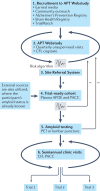Early-stage Alzheimer disease: getting trial-ready
- PMID: 35379951
- PMCID: PMC8978175
- DOI: 10.1038/s41582-022-00645-6
Early-stage Alzheimer disease: getting trial-ready
Abstract
Slowing the progression of Alzheimer disease (AD) might be the greatest unmet medical need of our time. Although one AD therapeutic has received a controversial accelerated approval from the FDA, more effective and accessible therapies are urgently needed. Consensus is growing that for meaningful disease modification in AD, therapeutic intervention must be initiated at very early (preclinical or prodromal) stages of the disease. Although the methods for such early-stage clinical trials have been developed, identification and recruitment of the required asymptomatic or minimally symptomatic study participants takes many years and requires substantial funds. As an example, in the Anti-Amyloid Treatment in Asymptomatic Alzheimer's Disease Trial (the first phase III trial to be performed in preclinical AD), 3.5 years and more than 5,900 screens were required to recruit and randomize 1,169 participants. A new clinical trials infrastructure is required to increase the efficiency of recruitment and accelerate therapeutic progress. Collaborations in North America, Europe and Asia are now addressing this need by establishing trial-ready cohorts of individuals with preclinical and prodromal AD. These collaborations are employing innovative methods to engage the target population, assess risk of brain amyloid accumulation, select participants for biomarker studies and determine eligibility for trials. In the future, these programmes could provide effective tools for pursuing the primary prevention of AD. Here, we review the lessons learned from the AD trial-ready cohorts that have been established to date, with the aim of informing ongoing and future efforts towards efficient, cost-effective trial recruitment.
© 2022. Springer Nature Limited.
Conflict of interest statement
The authors have received grants from the National Institute on Aging and research support from Eisai, Janssen and Lilly. P.S.A. has consulted for Abbvie, Biogen, ImmunoBrain Checkpoint, Merck, Rainbow Medical, Roche and Shionogi.
Figures





References
Publication types
MeSH terms
Substances
Grants and funding
LinkOut - more resources
Full Text Sources
Medical
Research Materials

